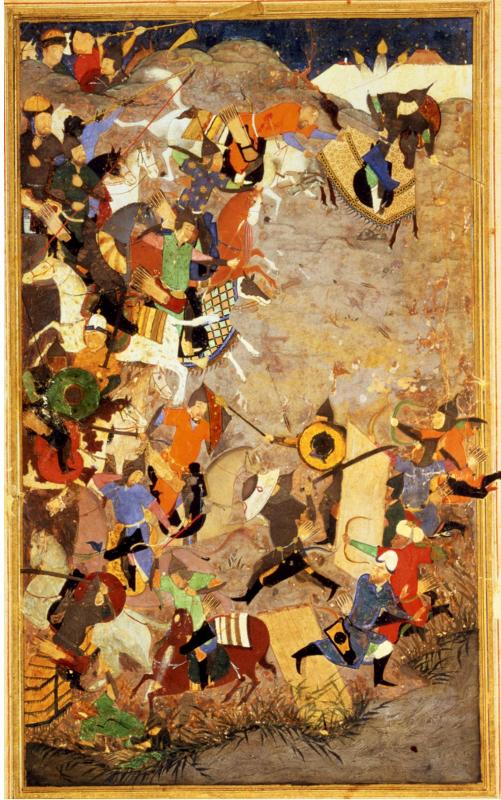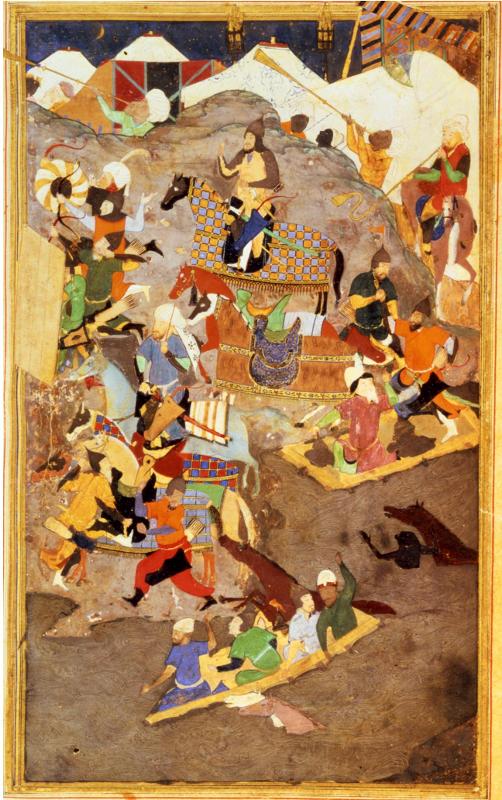
Try Amazon Fresh
Illustrations of Timurids in the Zafarnama of Sultan Husayn or ‘Garrett Zafarnama’
Battle on the River Oxus
 A larger image of Battle on the River Oxus (left) |
 A larger image of Battle on the River Oxus (right) |

 A larger image of Battle on the River Oxus (left) |
 A larger image of Battle on the River Oxus (right) |
Creation date: 1467-1468, creation date: illumination, ca. 1480s
Author: text by Sharaf al-Din ’Ali Yazdi (Islamic, died 1454)
Painter: illustrations by Bihzad (Persian, 1450-1536).
Held by: John Work Garrett Library John Hopkins University, Baltimore, Maryland.
The illustrated Zafarnama manuscript of Sultan Husayn, also known as the Garrett or Baltimore Zafarnama (Baltimore, Johns Hopkins University Library, no shelf mark), is one of the most celebrated and important among Timurid manuscripts. Produced in the fifteenth century, probably in Herat (present-day Afghanistan) for the famous Timurid ruler Sultan Husayn Mirza, the manuscript has survived in its entirety with minor retouching of the paintings, probably done in India.1 All twelve of its miniatures have been attributed to the great painter Bihzad by a later Mughal hand.
...
Folios 174v-175r: Umar Shaykh outmaneuvers Ankatura in a night attack on the Syr Darya in 790/1388 (Fig. 3) [vol. 1, 328]
Arnold identifies this scene as "The army of Umar Shaykh crossing the Oxus to attack the forces of Ankatura." Ankatura was a nephew of Amir Haji Beg Arkanut of Moghulistan. The soldiers of Umar Shaykh are crossing the river on rafts, which they hold in front of them as shields when they have reached the opposite bank. The attack was made at night since a crescent moon shines in a sky covered with stars; two torches are put between the tents of the enemy camp.24
There are several problems with Arnold's identification. The textual reference to this episode is found six folios before the miniatures. But the text that appears immediately before the illustrations is a passage similar to the one proposed by Arnold as the source of the image. However, that passage is not accurately shown in the paintings either. In the passage Arnold associates with the painting, the hero of the episode is a person named Amir Jahanshah (one of the local amirs) and not Amirzade Umar Shaykh.25 In the passage identified by Arnold, the troops had already crossed the river earlier in the day, while the painting shows the soldiers crossing at night; the text says that one group significantly outnumbered the other, while no such difference is represented in the miniature. The text does, however, describe the wooden screens that were used by the army of Amir Jahanshah as they appear in the painting.
Apart from the coincidence of the night battle on a river, the text located immediately next to the painting does not tell the story in the same way as the illustration. The passage is about a night attack led by Ankatura against Umar Shaykh in which it was actually the army of Ankatura that crossed the Syr Darya River in order to surprise the army of Umar Shaykh, who came to battle from an opposite direction. The text narrates that Ankatura attacked the Timurids, while the painting shows the Timurid army crossing the river and charging. It is clear that a conflation of these two episodes has occurred in the miniature since there is a visual emphasis on the Timurids: their army occupies all of the right-hand page and even spreads to the left page as well. The riderless horse with the tiger-skin caparison has been identified as the probable horse of Umar Shaykh, which appeared in the previous miniature. It is believed that the artist chose to distort his picture instead of rendering a perfectly literal image of the episode.26
Source: The Zafarnama [Book of Conquest] of Sultan Husayn Mirza by MIKA NATIF